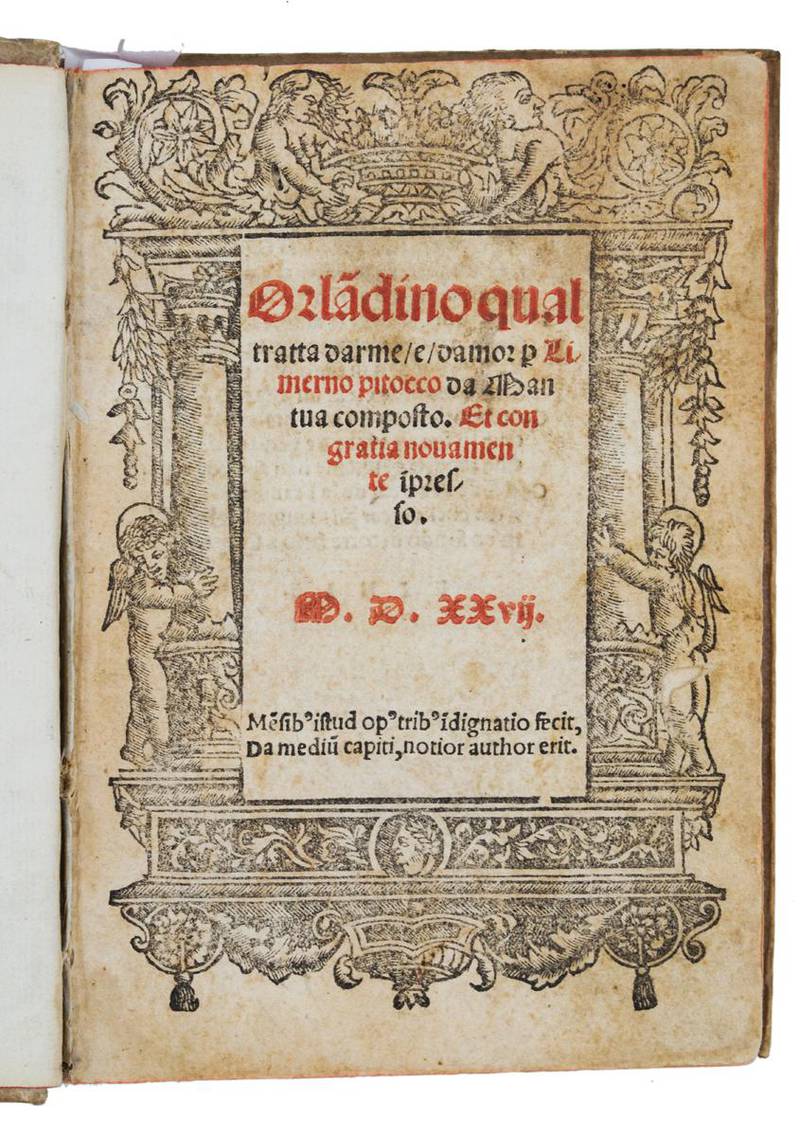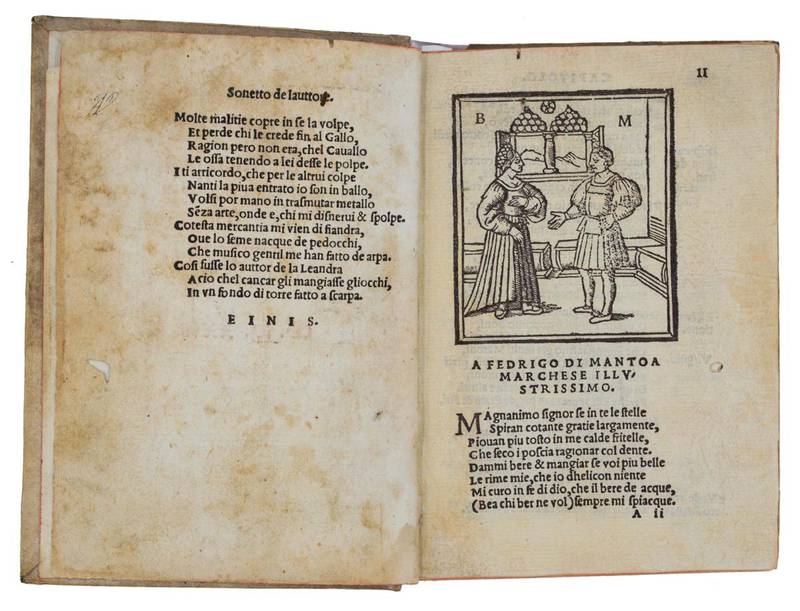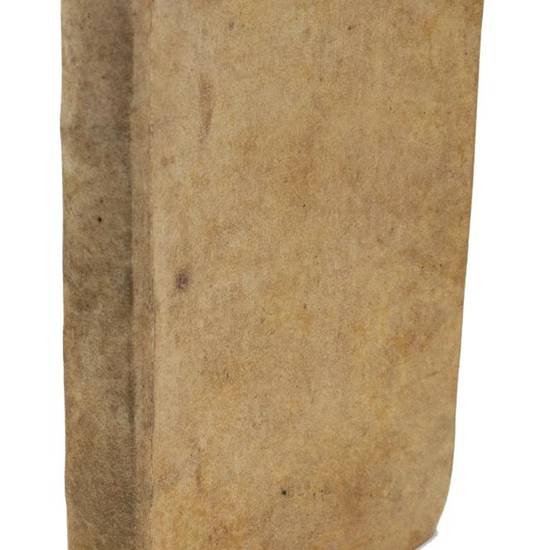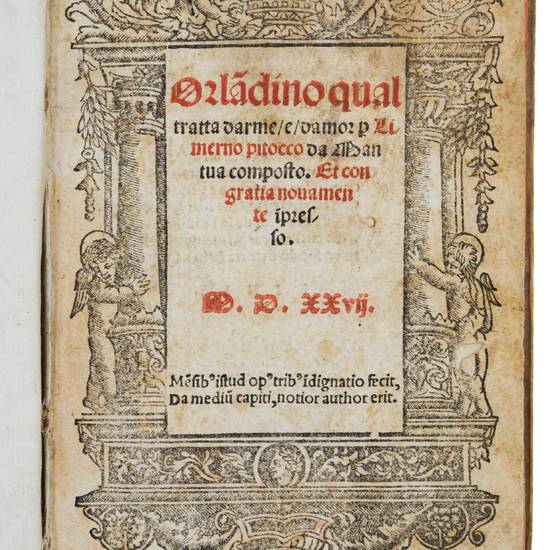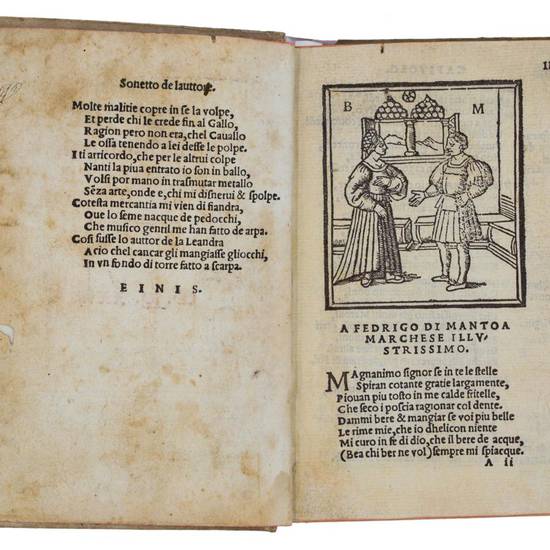8vo (155x111 mm); 19th-century stiff vellum, red edges; LXVI leaves. Collation: A-P4 Q6. Title-page printed in red and black within an elaborated woodcut frame. Half-page woodcut vignette on l. II (showing Berta and Milone), the same used in the 1526 editions of De Gregori and Da Sabbio with some retouching. On the pastedown bookplate of the booksellers from Barcelona “La Anticuaria Libreria de Llordachs Hermanos”. Title-page soiled, some foxing and browning, ink and damp stains on a few leaves, tear on l. XIX with no loss, round worm hole in the outer margin of the first thirty leaves not affecting the text, pin worm hole in the first twenty leaves that slightly affects the title-page border, the frame of the woodcut on the following page and a few letters. All in all a good copy. On last leaf recto ownership's entry by a certain Eliezer bar Silomo Debauzo (?); at the verso two notes in Hebrew.
The present is the last edition printed by Soncino in Italy before moving to Constantinople. It is the third of eight editions of Orlandino published in the 16th century. The first edition of the poem was printed in Venice on July 1526 for the bookseller Niccolò Garanta by Gregorio de Gregori, followed a few months later by another edition also issued for Niccolò Garanta by the da Sabbio brothers, which also includes a reprint of Folengo's Chaos.
Orlandino is a poem in octaves, which narrates the early years of Orlando, fitting into the semi-popular tradition of the ‘cantari' dedicated to the childhood of the hero. The poem is basically divided into two sections: the background (Berta and Milone, Orlando's parents, falling in love) occupies six books, while the hero's deeds are narrated in the seventh and final canto. Soncino's edition omits a few stanzas of the seventh canto and the entire eighth canto, which contains an anti-clerical tale on the fake abbot Griffarosto.
Orlandino is a harsh satirical work written in a hurry under a mood of indignation, not a long-meditated book such as the Baldus; a book in which the characters profess religious views tinged with Protestantism, reject papal authority, deride the sacrament of confession, and thunder against the sale of indulgences. It is a book apparently composed in three months (“mensibus tribus indignatio istud opus fecit”, as stated in the preliminary verses) and dominated by a bitter spirit, which often overwhelms the comic skills of the author (cf. T. Folengo, Orlandino, M. Chiesa, ed., Palermo 1991).
Teofilo Folengo, born Girolamo, was a native of Mantua. He entered the Benedictine order in 1509. In 1525 he was dispensed from his vows and, along with one of his brothers, led a wandering life, before deciding to return to the church. He was re-admitted to the order around 1534, after four years of penance in which he lived as a hermit.
In 1526 Folengo published in Venice two profane works, the Orlandino and the Chaos of Triperuno. In 1533 he wrote the religious poem, L'umanità del figlio di Dio, with the intention to redeem his past secular publications. In 1538 he was sent to Sicily near Palermo, together with many others monks from Mantua, eg Benedetto da Mantova, who between 1537 and 1539 composed the famous Beneficio di Cristo. Folengo wrote also a sacred representation, the Atto della Pinta, which was repeatedly staged. In 1542 he returned to the Veneto region. He died on December 9, 1544.
His masterpiece remains however the poem Baldus published together with other works in macaronic Latin under the title Opus Merlini Cocaii Poetae Mantuani Macaronicorum (first edition Venice 1517, best edition Toscolano 1521) (cf. Teofilo Folengo nel quinto centenario della nascita, Atti del Convegno, 1991, Florence, 1993).
USTC, 830143; Edit 16, CNCE42923 (1 copy at the Biblioteca nazionale Marciana in Venice); OCLC: 249563354 (1 copy at the Staatsbibliothek zu Berlin); Sander, I, no. 2834; Cat. Cavalieri, no. 765; Melzi-Tosi, p. 192; G. Manzoni, Annali tipografici dei Soncino, Bologna, 1886, III, pp. 125-127, no. 134 (he says he was never able to see a copy of this book); A. Nuovo, La parte volgare del catalogo di Gershom Soncino, in: “L'attività editoriale di Gershom Soncino, 1502-1527. Atti del convegno (Soncino, 17 settembre 1995)”, G. Tamani, ed., Soncino, 1997, pp. 73 and 92-93; E. Sandal, Indice cronologico delle edizioni latine e volgari di Girolamo Soncino (1502-1527), in: “Op. cit.”, p. 151, no. 110.
[8993]

